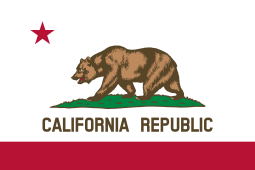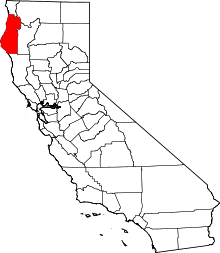Kneeland, California
Coordinates: 40°45′40″N 123°59′41″W / 40.76111°N 123.99472°W
| Kneeland | |
|---|---|
| Unincorporated community | |
|
Kneeland  Kneeland Location in California | |
| Coordinates: 40°45′40″N 123°59′41″W / 40.76111°N 123.99472°W | |
| Country | United States |
| State | California |
| County | Humboldt County |
| Elevation[1] | 2,129 ft (649 m) |
Kneeland (formerly, Kneeland Prairie)[2] is an unincorporated community in Humboldt County, California.[1]
It is located 7.5 miles (12 km) south-southwest of Korbel,[2] at an elevation of 2,129 feet (649 m).[1] Kneeland Airport is nearby. The ZIP code is 95549.[3]
Geography
Kneeland is located about 12 miles (19 km) east of Humboldt Bay, roughly equidistant from Eureka and Arcata (14 miles (23 km)).[4] It is 283 miles (455 km) north of San Francisco.[4]
Climate
This region experiences warm (but not hot) and dry summers, with no average monthly temperatures above 71.6 °F. According to the Köppen Climate Classification system, Kneeland has a warm-summer Mediterranean climate, abbreviated "Csb" on climate maps.[5]
History
Humboldt County was occupied by several native groups of at least two language families prior to and after the European settlers arrived. The Wiyot people used the area around Kneeland for salmon and locally harvested roots as well as lamprey from the Eel River and other subsistence food items. They may have used fire to maintain the prairies around Kneeland for hunting. Estimates of California Indian populations prior to the whites vary widely, but there were about 1500 to 2000 Wiyot in the Humboldt region shortly before the arrival of the whites, however due to the Indian Island Massacre, other massacre events, Indian wars, introduced diseases, starvation and forced relocations, they numbered around 100 individuals.[6] Today, many Wiyot live on the Table Bluff Reservation, located 16 miles (26 km) south of Eureka.[4] The area around Kneeland was not settled by whites until after the California Gold Rush brought waves of new settlers to the region to supply inland gold miners.[4]
The area around Kneeland was originally known as Kleizer's Prairie, but in 1852 with the establishment of a ranch by John A. Kneeland and his sister Mandana, the area became known as Kneeland's Prairie.[4][7] Other sources cite the name to Tom and John A. Kneeland, first American settlers there.[2]
As more settlers arrived, conflict with the Indians[6][8] resulted in the establishment of two U.S. Army stations Camp Lyon (1862) and Camp Iaqua (1863), nearby and Army soldiers patrolled settler's ranches.[4] Until the Homestead Act of 1862 permitted formal settlement, there were conflicts between settlers and squatters. The former small holders sold out in the 1870s and the land became consolidated into large ranches and at the turn of the century, these large ranches were owned by prominent local families.[4]
The first Kneeland school, which doubled as a meeting hall and a church, was built in 1869. Some stage hotels were built in the 1880s. The Kneeland post office operated from 1880 to 1891 and from 1892 to the present.[2] After World War II commercial logging drove the local economy. A sawmill was built and in 1962 a small airport was built nearby for emergency landings for small planes since the other Humboldt County airports often become fog bound before Kneeland.[4] The airport also provides facilities for CalFire.[4]
Economy
Kneeland has no central downtown district, the new 1952 Kneeland Elementary School building, the Kneeland Airport, and the Kneeland Volunteer Fire Department in the community. The post office closed in 2014. Logging continues in the surrounding timber.[4]
Most of the ranches and the few houses past the post office and toward Bridgeville are also referred to as Kneeland. The cemetery is a 8 miles (13 km) from the post office. Memorial Day weekend brings a few of the locals out for a cleanup and get-together to commemorate the history of this small community.
Education
Kneeland is the seat of the Kneeland Elementary School District,[9] and home of the Kneeland School,[10] a public K-8 school which started as a one-room schoolhouse, with separate outhouses for boys and girls, in 1873.[11] Two other schools were in operation at the time: Iaqua School (in Iaqua) and Lone Star (in Lone Star), but these were amalgamated with Kneeland School.[11] The school was modernized in 1951, and again in the 1980s.[11]
Demographics
According to the 2000 U.S. Census, the population of Kneeland was 244.[4] The population was 51.6% female and 48.4% male.[4] The median age of the population was 41.5, higher than the national median of 35.3.[4]
The population was 95.9% White, 1.6% Native American or Alaskan Native, 0.9% other races, and 1.6% identified with two or more races.[4] Only 2.2% of the population was foreign born, and of those, 50.0% were born in Guatemala.[4]
For the population 18 years and over, 89.3% had a high school education or higher: 8.6% had a high school diploma or equivalency, 32.1% had some college education but no degree, 39.0% had attained a bachelor's degree, and 9.6% had earned a graduate or professional degree.[4]
See also
-
 California portal
California portal
References
- 1 2 3 U.S. Geological Survey Geographic Names Information System: Kneeland, California
- 1 2 3 4 Durham, David L. (1998). California's Geographic Names: A Gazetteer of Historic and Modern Names of the State. Clovis, Calif.: Word Dancer Press. p. 89. ISBN 1-884995-14-4.
- ↑ USPS look up tool
- 1 2 3 4 5 6 7 8 9 10 11 12 13 14 15 16 Kneeland California Community Profile, NOAA Northwest Fisheries Service Technical, February 2007, accessed November 26, 2013
- ↑ Climate Summary for Kneeland, California
- 1 2 Sherburne Friend Cook (1943). The Conflict Between the California Indian and White Civilization. University of California Press. pp. 165–. ISBN 978-0-520-03142-5.
- ↑ Cooper, Russell, Kneeland through the years, January 1987, Humboldt Historian, January/February 1987, Vol. 38 Issue 1, page 16
- ↑ Robert Fleming Heizer (1993). The Destruction of California Indians: A Collection of Documents from the Period 1847 to 1865 in which are Described Some of the Things that Happened to Some of the Indians of California. U of Nebraska Press. pp. 264–. ISBN 978-0-8032-7262-0.
- ↑ Humboldt County Office of Education
- ↑ Kneeland School
- 1 2 3 Kneeland School History
